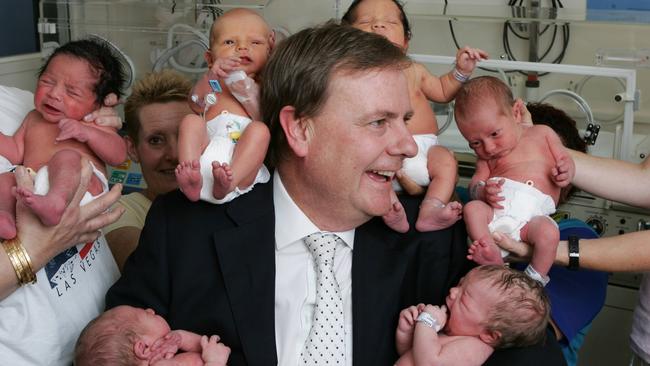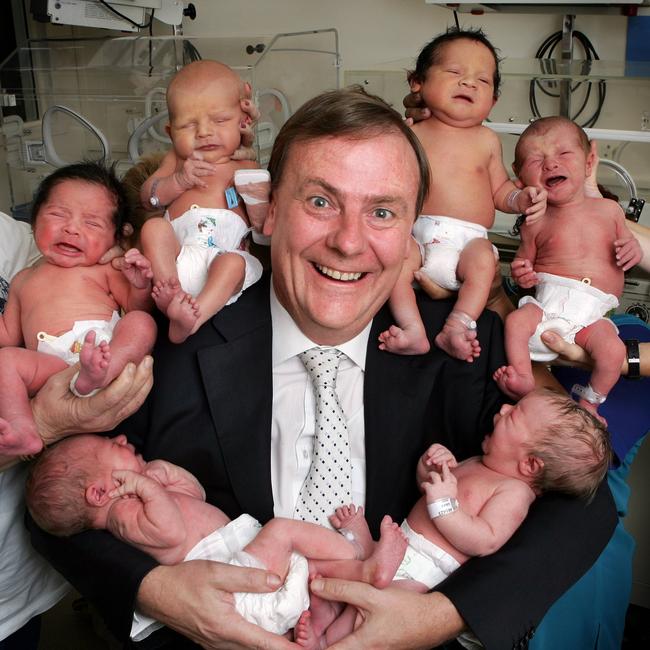Record low birth rate alarms Peter Costello
Peter Costello, who once implored couples to have another baby - ‘one for the country’ - is worried once more.

Former treasurer Peter Costello, who famously implored Australian couples to have another baby — “one for the country” — in 2004, is worried again.
With the nation’s birth rate hitting a record low in 2020, just 1.58 births per woman, according to new Australian Bureau of Statistics data, Mr Costello predicts serious flow-on effects for the economy.

“The drop in the fertility rate is building up a long-term and costly problem for the country,” he told The Australian.
“A falling fertility rate means our population is not replacing itself. It means our population is ageing. It means we rely on immigration more and more to supply the labour needed to look after the ageing population.”
ABS director of demography Beidar Cho noted that Covid-19 likely played its part in the lower birth rate last year, in which there were 294,369 registered births, almost 4 per cent fewer than in 2019 when the fertility rate was 1.66 births per woman.
Mr Costello agreed. “People would be worried about their future and future prospects for their children,” he said.
But policies to boost fertility were critical to the nation’s psyche, he said. “A rising birth rate is a vote of confidence in the future.”
Mr Costello’s 2004 budget measure, a $3000 Baby Bonus, did increase the birth rate for a ¬number of years, and it ticked above 2.0 in 2008.
But it has fallen since, even faster in recent years.
Demographer Peter McDonald said falling birth rates were an international trend in wealthier nations.
“Every English-speaking country is experiencing sharp falls in their birth rates, and even the Nordic countries, who supposedly have the best work-life policies, are seeing their birth rates plummet,” Professor McDonald said.

“The reason they are falling consistently over time is to do with the ability of women to combine work and family.
“Women are becoming more and more educated, and are more involved in the labour force and more able to succeed in the labour force.
“Each generation of parents is looking for more support to allow them both to work, and in recent years the level of support hasn’t changed all that much. We have a federal election coming up, and I suspect that issues like childcare will be high on the agenda for all parties.”
The ABS data shows only a few regional locations around the country have continued to accept the Costello invitation to “have one for mum, one for dad and one for the country”.
Those areas with a birth rate of 3 or more per woman include the Gunnedah, Kyogle and Murwillumbah regions in NSW, Colac in Victoria, Collinsville in Queensland and Tennant Creek in the Northern Territory.

No capital city areas have a birth rate above 3, with Sydney’s Lakemba (2.79 births per woman), Melbourne’s Mickelham-Yuroke (2.90) and Adelaide’s Elizabeth (2.45) among the highest.
Overall, Victoria had the lowest fertility rate in 2020, at 1.43 babies per woman, while the Northern Territory (1.77) and Western Australia (1.70) had the highest. Indigenous mothers had higher birth rates than the average for the population, according to the data.
“In 2020, the total fertility rate for Aboriginal and Torres Strait Islander mothers was 2.25 babies per woman,” Ms Cho said.
“There were 22,016 births registered (7 per cent of all births) where at least one parent was an Aboriginal and Torres Strait Islander Australian.”







To join the conversation, please log in. Don't have an account? Register
Join the conversation, you are commenting as Logout